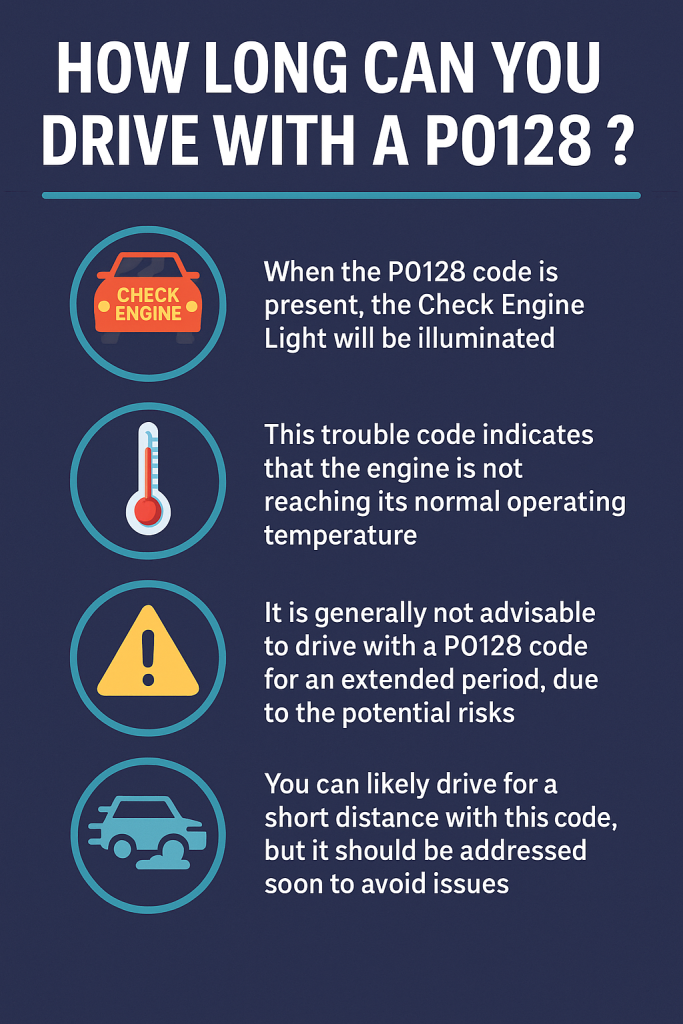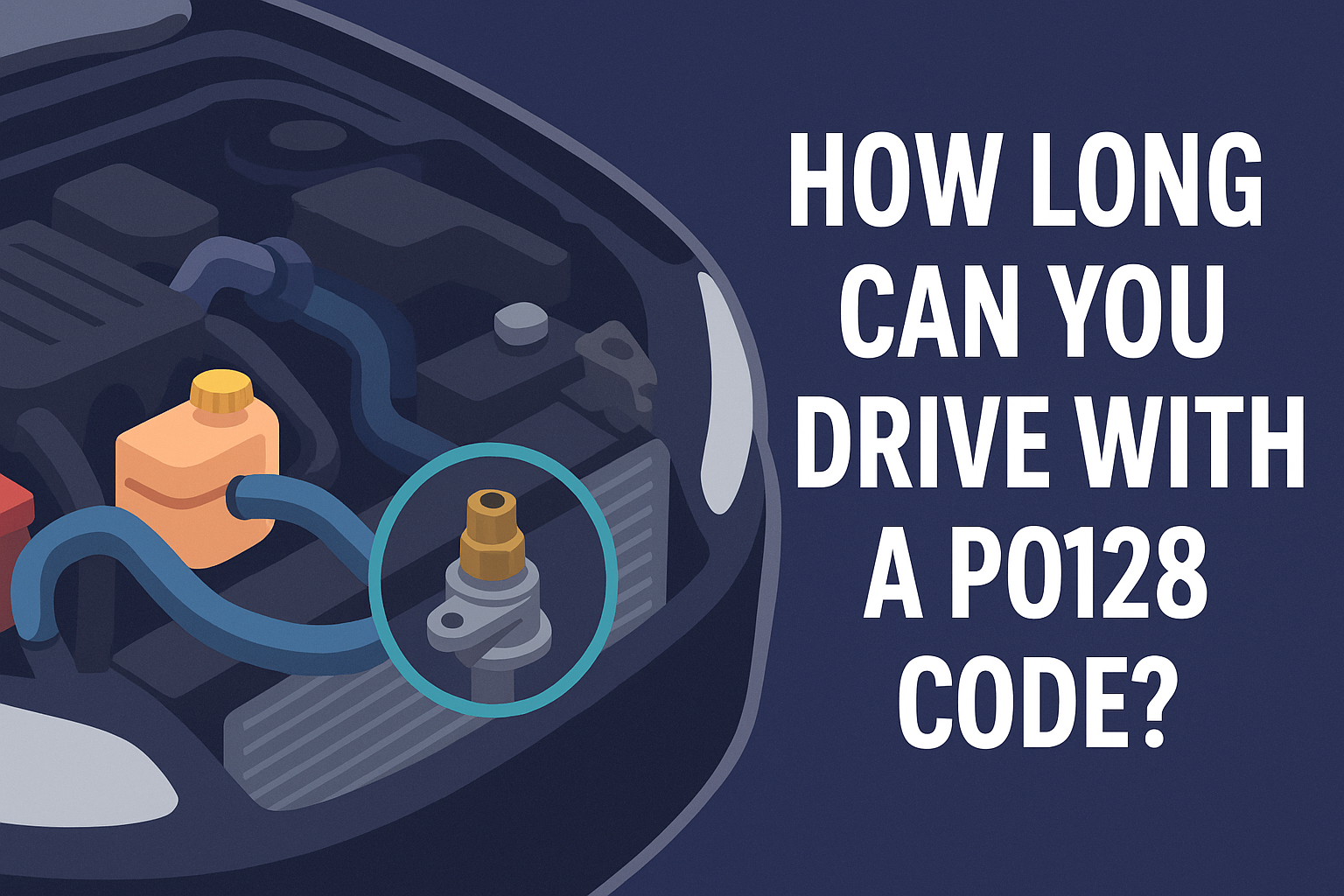Imagine driving your car on a chilly morning, only to see the check engine light pop up, followed by a scan tool reading P0128. This might leave you wondering—how long can I drive with this issue? More importantly, should you keep driving? Let’s dive deep into the meaning, risks, fixes, and prevention strategies for the P0128 code, so you can make an informed decision.
What Exactly Does P0128 Mean?
The P0128 diagnostic trouble code (DTC) stands for “Coolant Thermostat (Coolant Temperature Below Thermostat Regulating Temperature)”. In simpler terms:
- Your engine is taking longer than expected to reach its optimal operating temperature.
- This means your coolant isn’t warming up as it should, and the engine may be running cooler than ideal.
Your Engine Control Module (ECM) constantly monitors coolant temperature. When it notices that the coolant is not reaching the required temperature within a set time frame, it triggers the P0128 code.
What Causes a P0128 Code?
Here are the most common causes behind a P0128 code:
🔧 1. Stuck-Open Thermostat
The thermostat is responsible for controlling coolant flow through the engine. If it’s stuck open, coolant flows too freely, preventing the engine from warming up properly.
🔧 2. Faulty Coolant Temperature Sensor
If this sensor malfunctions, it may incorrectly report the coolant temperature to the ECM, leading to false triggers of P0128.
🔧 3. Low Coolant Level
Low coolant reduces heat transfer, slowing the engine’s warm-up process.
🔧 4. Cooling System Leaks
Leaks can cause coolant loss and reduce system pressure, leading to insufficient heating.
🔧 5. Radiator Fan Issues
A fan stuck on or malfunctioning can overcool the system, especially at idle or low speeds.
🔧 6. Electrical Problems
Faulty wiring or poor connections to the thermostat or sensor can mimic low-temperature signals.

Can You Still Drive With a P0128 Code?
The short answer is: Yes, but with caution.
Here’s a breakdown of what to expect:
🚗 Short-Term Driving:
- The car will still run, and you won’t notice major performance issues.
- You may experience reduced fuel efficiency, as the engine takes longer to reach ideal temperature.
- Heater performance may be weak, especially in colder weather.
- Emissions may increase slightly, which could lead to a failed inspection in areas with emissions testing.
🚗 Long-Term Driving:
- Constant driving with a P0128 can result in accelerated engine wear, as the engine might run rich (too much fuel) during cold conditions.
- Prolonged low-temperature operation can cause carbon buildup in the engine and exhaust system.
- Catalytic converter efficiency may decrease, as it relies on hot exhaust gases to function properly.
- Persistent issues may eventually trigger more error codes or mechanical failures.
How Long Can You Drive Before It Becomes Risky?
🔎 A few days to a few weeks is generally safe, provided you monitor for:
- Coolant leaks under the car
- Abnormal engine temperature fluctuations
- Signs of a failing thermostat (engine taking forever to warm up)
- Poor heater performance, especially in winter
🚨 However, it’s best not to delay repairs beyond a couple of weeks. Why?
- You risk long-term damage to your engine and emissions system.
- In colder climates, driving with a P0128 can make your car’s interior uncomfortably cold.
How to Diagnose the P0128 Code
🔍 Step 1: Check Coolant Level
Open the radiator cap (when cool) and check for low levels. Top off with the recommended coolant if needed.
🔍 Step 2: Inspect the Thermostat
- Look for visible signs of damage or corrosion.
- If your engine takes unusually long to reach normal temperature, the thermostat might be stuck open.
🔍 Step 3: Test the Coolant Temperature Sensor
- Use a multimeter to check resistance at various temperatures.
- Compare readings with manufacturer specifications.
🔍 Step 4: Check for Leaks
- Inspect hoses, the radiator, water pump, and around the thermostat housing.
- Look for puddles under the car or wet spots on components.
🔍 Step 5: Inspect Electrical Connections
- Look for loose wires, damaged insulation, or corroded connectors.
How to Fix a P0128 Code
🛠 Replace the Thermostat
- The most common fix is replacing a faulty thermostat.
- Thermostats are relatively inexpensive and usually easy to access.
- Always use the OEM-recommended temperature rating.
🛠 Replace the Coolant Temperature Sensor
- If the sensor is faulty, replace it with a new one.
- This ensures accurate readings to the ECM.
🛠 Refill or Flush Coolant
- If coolant levels are low, top them off.
- If contaminated, flush and refill the system.
🛠 Repair Cooling System Leaks
- Replace cracked hoses, faulty gaskets, or leaking radiator components.
🛠 Check and Repair Wiring
- Secure or replace damaged wires or connectors in the thermostat or sensor circuits.
Potential Costs of Ignoring a P0128 Code
💰 Lower Fuel Efficiency: Expect a noticeable drop in MPG.
💰 Engine Wear: Over time, carbon buildup and improper lubrication can cause damage.
💰 Failed Emissions Test: If your area requires emissions testing, your car may not pass.
💰 Heater Malfunction: Your heater might blow cold air, especially in winter.
💰 Potential Engine Damage: Rare but possible if combined with other issues.
Can a P0128 Code Cause a Breakdown?
Not directly, but it’s a warning sign. If the thermostat or sensor fails completely, it can cause more serious problems:
- A stuck thermostat might eventually overheat the engine if it fails in the closed position.
- Combined issues (like a leak + stuck thermostat) can lead to coolant loss and overheating.
Tips to Prevent a P0128 Code in the Future
✅ Use High-Quality Coolant: Always use manufacturer-recommended coolant and maintain proper levels.
✅ Replace Thermostat on Schedule: Some thermostats wear out over time—replace it during major coolant system work.
✅ Flush the Cooling System: Follow your vehicle’s maintenance schedule to flush and replace coolant.
✅ Check for Leaks Early: Address small leaks before they become major.
✅ Keep Electrical Connections Clean: Moisture and corrosion can cause sensor issues.
Summary: What Should You Do?
🔸 Yes, you can drive with a P0128 code temporarily.
🔸 Address it as soon as possible to avoid long-term damage and poor fuel economy.
🔸 If you notice other issues (like leaks, low coolant, or odd temperature readings), don’t delay repairs.
🔸 A thermostat or coolant sensor replacement is a simple, cost-effective solution.

